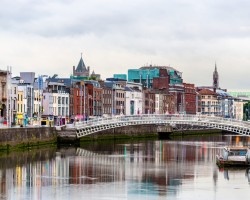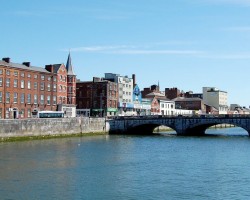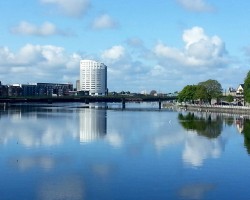Best time to go to Ireland for a perfect weather and where to go?
When is the best time to go to Ireland?
The best time to visit Ireland is from May to late October. However, every season has its charm and it is entirely possible to consider a trip at any time of the year. It all depends on the experiences you want to have!
It must be said that weather is a favorite topic for the Irish and its vagaries are an integral part of the island. Be aware: there is little chance that you will escape the rain during your stay! It can take various forms, from a light refreshing drizzle to a heavy rain that soaks everything in its path. However, the weather changes quickly and generally the rains are quite short, giving way to very beautiful sunny moments. It is likely that you will experience all four seasons in one day!
When is the best time to visit Ireland to fully enjoy all aspects of the island? Summer is a good option, although July and August mark the peak tourist season. During this period, the weather is mild, there are festivals everywhere, and the evenings seem endless.
For a more peaceful experience, opt for the months of May and June. It is indeed in spring that nature offers the most lush and flowery landscapes. The ideal way to explore them is by hiking. September is also a good month to discover Ireland, although the crowds are still significant. In October, the kaleidoscope of autumn leaves is at its peak, offering visitors magical panoramas! Finally, if you want to feel like you are alone in the world in postcard-worthy landscapes, winter is splendid in Ireland.
In terms of budget, expenses are relatively stable throughout the year, with some variations: accommodation is a bit more expensive during peak seasons, generally between May and September. As for flights, October turns out to be the most expensive month. To limit costs, renting a van or a camper can be a good solution, and Ireland is an ideal country for this kind of road trip. Although the regulations are quite strict, especially in July and August, some places allow overnight parking, especially in the countryside. You can then save on food and accommodation expenses, while being completely independent in your travels.
Where and when to go based on the weather?
Connacht
Galway, Connemara National Park, Belmullet...
Leinster
Dublin, Kilkenny, Dundalk...
Munster
Cork, Dingle, Limerick...
North East Ireland (Ulster)
Letterkenny, Killybegs, Dungloe...
To get all the information about the climate and weather in Ireland for a specific month, click on the corresponding link below:
Ireland in january Ireland in february Ireland in march Ireland in april Ireland in may Ireland in june Ireland in july Ireland in august Ireland in september Ireland in october Ireland in november Ireland in december
Best time to travel to Ireland by cities
Climate and Weather in Ireland
Due to its geographical location, not far from England, Scotland, and Wales, the climate in Ireland is of an oceanic and temperate summer type. Also known as "the Emerald Isle," the island is renowned for its humidity, with no less than 250 days of rain per year! However, it is thanks to this humidity that Ireland boasts such beautiful and wild landscapes. Moreover, it is the perfect opportunity to admire very beautiful rainbows, as they are very common in Irish land.
The rainiest regions of the island are located in the west: in the mountainous area of Munster and towards Cork, as well as in the province of Connacht where Galway is situated. In contrast, the eastern coast of Leinster is much drier, especially towards Dublin.
In addition to rain, the weather in Ireland is characterized by a small temperature range, with mild temperatures throughout the year, and very changeable weather. Added to these capricious weather conditions is the wind, which is quite present and can blow for several days, especially along the coast. The north and west coasts are even included in the windiest regions in Europe.
Despite a common climate throughout the territory, some variations can be noted depending on the regions:
- In the west, in Munster and Connacht, the best period extends from May to October. Temperatures range from 12 to 19°C, but showers are frequent.
- In Leinster, the weather is similar in May, June, and October. However, from July to September, the period is very favorable, with averages between 16 and 19°C, as well as light rainfall.
- In Ulster, in Northern Ireland, the climate is harsher and the good season shorter than elsewhere. Opt for the months of May, June, September, and October to discover this region, as July and August are particularly rainy and gray.

Summer in Ireland
It is between June and early September that temperatures are most pleasant in Ireland. They peak on average at 18-19°C, with occasional spikes above 20°C. Showers are always possible, especially in the west and north, but the east coast and south are relatively spared.
This is the ideal time to explore the country and engage in many outdoor activities, such as hiking, kayaking, or water sports. Another advantage of this season: it stays light until late in the evening. If you are brave, swimming is possible with water temperatures around 16°C in August.
Autumn in Ireland
If you want to avoid the summer crowds, autumn is a good option to visit Ireland. The early season, from late September to late October, offers still pleasant temperatures and a burst of colors in the trees. For example, it is between 14 and 16°C in Cork and Dublin. Expect one or two degrees less in Connemara. On the flip side, the weather is even more unstable than in summer and can change completely in a short time.
Winter in Ireland
Winter remains mild in Ireland with highs around 10°C in much of the country. Generally, the east and center of the country are cooler than the west, where the weather is softened by the Gulf Stream, an Atlantic Ocean current.
Negative temperatures are very rare in Ireland, but the island can still experience snowy episodes occasionally. The month of December is the rainiest of the season, especially in Galway and Belmullet or Dungloe, further north.
Although winter is not conducive to outdoor activities, city trips are entirely possible. Certainly, the days are short and quite dark, but it's an opportunity to relax in one of the many pubs or visit museums.
Spring in Ireland
Between late March and early June, temperatures start to rise and spring sunshine warms the air. Everywhere, the first buds begin to bloom, and the island is covered with multicolored flowers and electric green grass.
The month of March is the least rainy of the year, but the atmosphere remains a bit cool with temperatures around 10°C. In April, the thermometer rises significantly, but rain returns over much of the territory. May and June remain humid and unstable. However, temperatures are particularly pleasant with highs between 15 and 17°C depending on the area.
Temperatures and rainfall in Ireland
On these 3 graphs, we present the evolution of temperatures of Ireland and month-by-month rainfall for the cities of Dublin, Cork, Galway, Belmullet and Connemara National Park, as well as the month-by-month sea temperature for coastal cities.
Peak visitor numbers and tourist seasons in Ireland
Find out when Ireland has its high tourist season (the period when the influx of tourists is highest) and off-peak tourist season using our data and figures.
Tourist seasons in Ireland
The months with low numbers of tourists are: January, February, March, April, October, November and December. The number of visitors to Ireland is high in: May, June, July, August and September.
- Very low season in Ireland: February, March and November.
- Low season in Ireland: January, April, October and December.
- High season in Ireland: May, June and September.
- Peak season in Ireland: July and August.
Figure: Visitor index for Ireland month by month
Average price for flights to Ireland
A return flight between New York City and Dublin is generally cheaper if you go in february ($ 528 on average): this is the best time for travellers on a tight budget. In contrast, you may end up paying $ 428 more for your airline ticket to Dublin if you go in july.
Find the best price for your flight Flight prices to Ireland
Where to go in Ireland?
This table allows you to see the maximum temperature for each city and our opinion on the weather month by month (see colour legend below the table).
| Cities | jan. | feb. | mar. | apr. | may | jun. | jul. | aug. | sep. | oct. | nov. | dec. |
| Dublin | 8°C | 9°C | 10°C | 11°C | 14°C | 16°C | 18°C | 18°C | 16°C | 14°C | 11°C | 9°C |
| Cork | 9°C | 9°C | 10°C | 12°C | 14°C | 17°C | 19°C | 18°C | 17°C | 14°C | 11°C | 9°C |
| Galway | 9°C | 9°C | 10°C | 13°C | 15°C | 17°C | 18°C | 18°C | 17°C | 14°C | 11°C | 9°C |
| Belmullet | 10°C | 9°C | 10°C | 11°C | 12°C | 14°C | 16°C | 16°C | 15°C | 14°C | 12°C | 10°C |
| Connemara National Park | 7°C | 7°C | 9°C | 11°C | 13°C | 15°C | 16°C | 16°C | 15°C | 12°C | 9°C | 8°C |
| Dingle | 10°C | 9°C | 10°C | 12°C | 13°C | 15°C | 17°C | 17°C | 16°C | 14°C | 12°C | 10°C |
| Dundalk | 7°C | 8°C | 10°C | 12°C | 14°C | 17°C | 18°C | 18°C | 16°C | 13°C | 10°C | 8°C |
| Dungloe | 7°C | 8°C | 9°C | 12°C | 14°C | 16°C | 17°C | 17°C | 16°C | 13°C | 10°C | 8°C |
| Kilkenny | 8°C | 9°C | 10°C | 12°C | 15°C | 17°C | 19°C | 18°C | 17°C | 14°C | 10°C | 8°C |
| Killybegs | 8°C | 8°C | 10°C | 12°C | 14°C | 16°C | 17°C | 17°C | 16°C | 13°C | 10°C | 8°C |
| Letterkenny | 7°C | 8°C | 10°C | 12°C | 14°C | 17°C | 18°C | 18°C | 16°C | 13°C | 10°C | 7°C |
| Limerick | 8°C | 9°C | 11°C | 13°C | 15°C | 18°C | 19°C | 18°C | 17°C | 14°C | 10°C | 9°C |
| Achill Island | 10°C | 9°C | 10°C | 11°C | 12°C | 14°C | 16°C | 16°C | 15°C | 14°C | 12°C | 10°C |
| Aran Islands | 10°C | 10°C | 10°C | 12°C | 13°C | 15°C | 17°C | 17°C | 16°C | 15°C | 12°C | 10°C |
| Ardmore | 9°C | 9°C | 10°C | 12°C | 14°C | 17°C | 19°C | 18°C | 17°C | 14°C | 11°C | 9°C |
| Ballycastle | 10°C | 9°C | 10°C | 11°C | 12°C | 14°C | 16°C | 16°C | 15°C | 14°C | 12°C | 10°C |
| Birr | 8°C | 8°C | 10°C | 13°C | 15°C | 17°C | 19°C | 18°C | 17°C | 14°C | 10°C | 8°C |
| Bundoran | 8°C | 8°C | 10°C | 12°C | 14°C | 16°C | 17°C | 17°C | 16°C | 13°C | 10°C | 8°C |
| Burren National Park | 8°C | 9°C | 10°C | 13°C | 15°C | 18°C | 19°C | 18°C | 17°C | 14°C | 11°C | 9°C |
| Cashel | 8°C | 8°C | 10°C | 12°C | 14°C | 17°C | 19°C | 18°C | 17°C | 14°C | 10°C | 8°C |
Legend:
good weather
tolerable weather
bad weather
very bad weather
About Ireland
What can I do in Ireland?
Beaches / swimming
Nature and countryside
Culture and heritage
Sports
Family travel
Crafts / shopping
Gastronomy
Nightlife
Is this weather information for Ireland reliable?
Climate data for Ireland has been gathered every day since January 2009. The analysis of these meteorological data for Ireland allows us to determine the average for each month in Dublin, Cork, Galway, Belmullet, Connemara National Park, Dingle, Dundalk, Dungloe, and 80 other cities.
So yes: this data is reliable except in cases of temporary climate disruption in the region.






